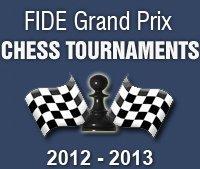
2009 Holiday Puzzler Answers And Winners
So how well did you do in the 2009 Chess.com Holiday Puzzler?
There were 20 chess related questions, and a total of 32 marks to earn, but how many did you answer correctly?
The standard of entries was extremely high, and Chess.com would like to say a very BIG thank you to everyone who took part.
Seven entries received full marks, and a further four had just one wrong! Due to the high quality of the answers, the number of prizes has therefore been increased, and the lucky winners are below (all had full marks unless shown).
First prize: One year Diamond membership, plus t-shirt to Luis3141
Second prize: One year Platinum membership, plus t-shirt to NCKChess
Third prize: One year Gold membership, plus t-shirt to addiction_to_chess
Fourth prize: One month Diamond Membership, plus Chess.com t-shirt to JDudar
Fifth-Eleventh prize: One month Diamond Membership to Mathijs, benws, peter2, WanderingWinder (31), Bondiggity (31), mottsauce (31), Eiwob (31)
If you are one of the winners, then congratulations! Chess.com will be in touch with you shortly to arrange for you to receive your prize. If you just missed out please don't despair, there is always next year! Anyone who is still unsure of their score after reading the answers, just send me a message and I'll let you know.
1. In which year was the first international chess tournament held, and who won the event? Any easy one to start! The first international chess tournament was held in 1851 (1 point) and was won by Adolf Anderssen (1 point).
2. Can you solve this fun selfmate chess problem? It's WHITE's turn to move and he must force BLACK to checkmate HIM in four moves.
|
|
Selfmate problems are a fascinating variation on the normal 'play-to-win' puzzles, and are impossible to solve by plugging the position into a computer engine! (1 point for full solution)
3. Can you unscramble the following anagrams to find the names of five famous chess players? (1 point for each)
- Violent Love Spa - Veselin Topalov
- Savvy Silica Hunk - Vassily Ivanchuk
- Auto Adrenal Sex Kink - Alexandra Kosteniuk
- Devour Major Bait - Teimour Radjabov
- Drank Milk Via Rim - Vladimir Kramnik
4. Name this famous chess player, coach and author of instructional chess books for amateurs? Most people got this one! It's Chess.com columnist Jeremy Silman. (1 point)
 |
5. What creation of designer Charles Eames played a part in a famous match for the world chess championship? Charles Eames designed the Time-Life Executive Chair (1 point) that Bobby Fischer insisted on using during his match with Boris Spassky in 1972. Spassky was so impressed, he asked for one too!
 |
6. Who am I? Born in Brooklyn, I twice won the New York State Championships and during my career defeated Harry Pillsbury and Frank Marshall. I am also regarded as one of the most important chess journalists in history, writing a regular chess column for over 50 years. Herman Helms (1 point) defeated Pillsbury and Marshall and wrote as a chess columnist for the New York Times for more than half a century.
7. In the film 2001: A Space Odyssey, the astronaut Frank Poole plays - and loses - a game of chess with the ship's computer HAL. The moves of the game (see below) were actually based on a real game, but which German master played the black pieces? The German master Willi Schlage (1 point) played the black pieces.

8. Which brilliant Soviet chess champion said, "The most powerful weapon in chess is to have the next move". The great David Bronstein (1 point) is the author of this quote.
9. Can you identify these five chess players from their nicknames? (1 point for each)
- The Pride and Sorrow of Chess - Paul Morphy
- The Chess Machine - J.R. Capablanca
- The Tiger of Madras - Viswanathan Anand
- The Beast of Baku - Garry Kasparov
- The Surgeon - Alex Sherzer (this one is a lot trickier than the others!)
10. Who are the players portrayed in this absorbing work of fantasy chess art?

The two players are siblings Greg Shahade (1 point) and Jennifer Shahade (1 point). This striking image was created by young Danish artist and chess player Carina Jorgensen, who has many other interesting works at her website.
The member who found the answer by blowing up the image to read the scoresheet must have remarkably good eyesight!
11. Which brilliant player defeated Capablanca, Lasker and Alekhine in the first tournament matches that he played against them, but never faced any of them in a match for the world title? This unassuming question turned out to be one the trickiest in the competition. The correct answer is Akiba Rubinstein (1 point). There were other players who defeated all three champions, but not in their FIRST tournament match with them, as the question asked.
12. Can you solve the following beautiful composed problem? White to play and force checkmate in just three moves.
|
|
If you give this position to a computer engine e.g. Rybka or Fritz then they show a mate in four moves, not three. Computer engines don't look for the quickest checkmate, so unless you had seen this puzzle before you had to work it out yourself - I hope!
The key move of the solution is 1.Qf1 ! (1 point). For another mark, you needed to explain why this move works by giving clear explanations/variations, including white's response to 1...g3 (1 point). This clever problem was created by Sam Loyd and is sometimes called the "Love Chase" as the Queen seems to chase the Bishop around the board!
13. The great Mikhail Tal had an attractive attacking style that gave him a positive score against many of his illustrious opponents. However, he had great trouble with one particular opponent, whose style was very different to his own. A fellow player summed up the difference: "X's style is Tal's style, as though turned inside out. Tal always strives to seize the initiative, whereas X is ready to concede it without regret. Tal likes to attack, X to defend." Who is the mysterious player X?
Player X is Viktor Korchnoi (1 point)
14. Name the Grandmaster keeping warm in the stylish hat.

The player is Boris Gelfand (1 point) at the recent World Cup tournament which he won.
15. What is the name of the International Chess Master and prolific writer who made a famous bet in 1968 that no computer program would beat him in a chess match within 10 years? And, did he win the bet? David Levy (1 point) was the player, and he won his bet (1 point).
16. After just four moves of a crazy chess game, the position shown below was reached. But what were the first four moves of the game to get to this position?
This puzzle seems like it should be simple, but unless you realise that it is black's b8 knight that has been taken, not his g8 knight, you could struggle to find the solution! (1 point)
|
|
17. In the days before time restrictions were imposed on chess player's deliberations, games could be interminably long. Who said, "The slowness of genius is hard to bear, but the slowness of mediocrity is intolerable!" Henry Thomas Buckle (1 point).
18. This man probably played chess against more people than anyone else during 2009, but who is he?
 |
This is US astronaut Greg Chamitoff (1 point), who played a "vote-chess" game against his many ground-based adversaries! The background image of the space station should have been a clue!
19. Who was the first American to win a world chess championship of any kind?
This was the toughest question of all. Many thought it was Paul Morphy, but although Morphy was widely regarded as the best player in the world during his lifetime, he never won a world championship because no such title existed at that time. Others also thought it was Bobby Fischer, but an American won a world chess title before Bobby.
The correct answer is William Lombardy (1 point), who won the World Junior Chess Championship in 1957. A clever but incorrect alternative possibility was Wilhelm Steinitz. Steinitz won the first official match for the World Chess Championship in 1886 playing under the American flag, but he was still an Austrian citizen at the time. He later defended the title as an American, but he was Austrian when he initially won the title. This possible ambiguity was clarified in the comments by adding the definition of "American" as a natural-born American citizen.
20. These famous and remarkable chess pieces are part of a set which dates from the 12th century, but what are they known as?
 |
These ancient pieces were discovered on the Isle of Lewis in the Outer Hebrides, Scotland, UK. They are called the Lewis Chessmen (1 point) or sometimes the Uig Chessmen (also correct).
